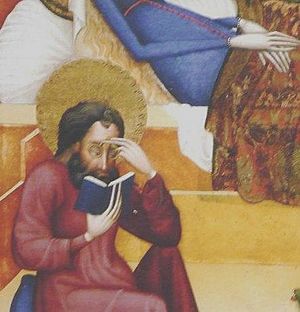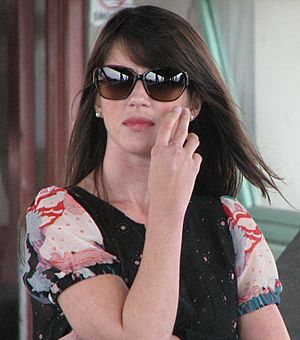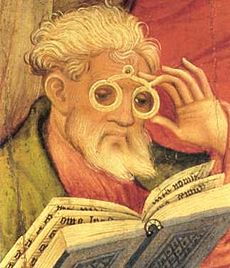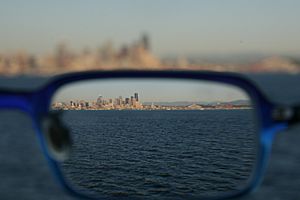Eyeglasses facts for kids
Eyeglasses, also known as spectacles, are special helpers for our eyes. They have clear pieces of glass or plastic, called lenses, held in a frame. These lenses sit right in front of your eyes.
Corrective lenses help people who have trouble seeing or reading clearly. They make things look sharp again. Contact lenses are another way to help people see better.
Sunglasses are a type of eyeglasses that protect your eyes from too much sunlight. Some eyeglasses also block harmful blue light from computer screens, phones, and TVs.
Eyeglasses come in many cool styles, so people often wear them for fashion.
Contents
History of Eyeglasses
Early Ideas for Magnification


People have thought about using lenses to make things look bigger for a long time. An Arab scientist named Alhazen wrote about how a convex lens (a lens that curves outwards) could make images larger in his book Book of Optics around the year 1021. This book was later translated into Latin, which helped lead to the invention of eyeglasses in Italy.
Later, in the 1200s, an English scholar named Robert Grosseteste wrote about using optics to "read the smallest letters." Another scholar, Roger Bacon, also wrote about how lenses could magnify things.
Before eyeglasses, people in China used flat pieces of smoky quartz as a type of sunglasses in the 1100s. The Inuit people also used snow goggles to protect their eyes from bright snow glare. These didn't correct vision, but they helped people see better by reducing light.
When Eyeglasses Were Invented
The very first eyeglasses were made in Italy around 1286. We don't know for sure who invented them. A friar named Giordano da Pisa said in 1306 that the art of making eyeglasses was less than 20 years old. He even said he knew the person who first made them.
Another friar, Alessandro della Spina, also started making eyeglasses and shared them with everyone. By 1301, there were rules in Venice about selling eyeglasses, which shows they were becoming popular.

The oldest picture showing someone wearing eyeglasses is a painting from 1352 by Tommaso da Modena. It shows a cardinal reading with glasses.
These early glasses had convex lenses. They could help people who were farsighted (had trouble seeing things up close) or who had presbyopia. Presbyopia is when your eyes naturally lose their ability to focus up close as you get older. It wasn't until 1604 that Johannes Kepler explained how different lenses could fix both farsightedness and nearsightedness.
The first eyeglass frames were two magnifying glasses joined together. They would grip the nose. These are called "rivet spectacles." Some of the oldest ones found date back to around 1400 in Germany.
Glasses in Society and Fashion
For a long time, glasses were seen as a medical device. Wearing them sometimes carried a negative image, making people seem old or weak.
The normalization of eyeglasses on television and stage is a fascinating piece of cultural history. It wasn't the work of a single person, but rather a gradual process driven by a few key figures who broke the mold. Together, they dismantled the old Hollywood stigma that glasses were unattractive or comedic, transforming them into an accepted, and often powerful, part of a public persona.
The following individuals were crucial in this transformation:
Pioneers Who Broke the Stigma
- Harold Lloyd (1893-1971)
- Role: The Silent Film Comedian
Long before television, Lloyd was the first major entertainer to make glasses a central, positive part of his identity. His "Glass Character" wore round, horn-rimmed spectacles (often just lenses without actual prescription) and was the antithesis of a clumsy nerd. He was an ambitious, all-American go-getter—thrill-seeking, romantic, and successful. He proved that a man in glasses could be a heroic and hilarious leading man, making them a lovable and aspirational symbol for millions of fans.
- Elvis Presley (1935-1977)
- Role: The King of Rock 'n' Roll
In the 1950s, Elvis was the epitome of cool. When he was photographed and filmed wearing glasses offstage—particularly his iconic, thick, black-rimmed styles—he single-handedly made them acceptable for a young, hip audience. If the coolest man on the planet wore glasses, they couldn't be uncool. His 1968 'Comeback Special' featured him wearing reading glasses during an intimate studio session, further cementing their place in pop culture.
- John Lennon (1940-1980)
- Role: The Iconic Musician and Intellectual
Lennon's choice of the round, "teashade" and "granny" glasses in the mid-1960s was a deliberate stylistic and philosophical statement. They became synonymous with the peace, love, and intellectualism of the counterculture movement. He didn't hide his glasses; he made them a core part of his iconic look, proving they could be a powerful fashion accessory and a symbol of a thoughtful, artistic mind.
The Television News Anchors
- Walter Cronkite (1916-2009)
- Role: "The Most Trusted Man in America"
As the anchor of the CBS Evening News for decades, Cronkite was a fixture in American living rooms. He was often seen wearing his distinctive, heavy-rimmed glasses. His immense credibility and authority made glasses look not like a weakness, but like a tool of a serious, intelligent, and trustworthy journalist. He made it okay for a nation's father figure to wear spectacles.
- David Brinkley (1920-2003)
- Role: Pioneering TV Journalist
Alongside Cronkite, a generation of newsmen like David Brinkley and, later, Mike Wallace of 60 Minutes, consistently appeared on camera in glasses. They collectively established the "man in glasses" as the default image of a reputable news source, moving glasses firmly into the realm of authority and gravitas.
Later Icons Who Made Them Cool
- Woody Allen (b. 1935)
- Role: The Neurotic Auteur
Throughout the 1970s and 80s, Allen's oversized glasses became as much a part of his on-screen persona as his wit. While his character was often anxious, the glasses became a trademark of the intellectual, creative, and idiosyncratic filmmaker.
- Jerry Seinfeld (b. 1954)
- Role: The Observational Comedian
On his massively popular sitcom Seinfeld, Jerry was almost always glasses-free. However, in his stand-up comedy segments that opened and closed each show—the "real" Jerry—he almost always wore them. This subtly reinforced the idea that glasses were the tool of a sharp, observant comedian, the "real" person behind the TV character.
- Drew Carey (b. 1958) & Lisa Loeb (b. 1968)
- Role: The 90s Mainstreamers
Drew Carey's thick-rimmed glasses on The Drew Carey Show made a geeky look friendly and mainstream. Meanwhile, singer Lisa Loeb's iconic tortoiseshell frames, featured prominently in her "Stay" music video, created a massive trend in the 1990s, making thick, plastic frames a must-have fashion accessory for young women.
Different Types of Eyeglasses
Eyeglasses come in many styles and are used for different reasons. Sometimes, they even combine uses, like prescription sunglasses.
Corrective Eyeglasses
Corrective lenses help fix common vision problems. They bend the light entering your eye so that images focus correctly. This helps with conditions like nearsightedness (when distant objects are blurry) or farsightedness (when close objects are blurry). They also help with astigmatism, which causes blurry vision at all distances.
As people get older, their eyes can change. Many people over 40 develop presbyopia. This makes it hard to focus on nearby objects. Corrective lenses are made to fit a special prescription from an eye doctor. Wearing the right glasses can greatly improve how you see and can even reduce problems like headaches from eye strain.
Pinhole glasses are a different type of corrective glasses. They don't use lenses. Instead, they have tiny holes that help focus light. However, they have many limits and are not used for everyday vision correction.
The most common type of corrective lens is "single vision." This means the whole lens has one power. For people with presbyopia, bifocals have two different powers (one for distance, one for reading). Trifocal glasses have three powers. Progressive lenses offer a smooth change in power from distance to near vision.
Reading glasses are another option for focusing on close-up objects. You can buy them without a prescription at stores. They are a simple solution, but they don't fix more complex vision problems like astigmatism. For the best vision, you need glasses made to your specific eye doctor's prescription.
Safety Eyeglasses
Safety glasses are worn to protect your eyes in dangerous situations. They have strong, break-proof plastic lenses. These lenses protect your eyes from flying pieces of material or harmful liquids.
Many workers, like those in construction, factories, or labs, must wear safety glasses. This protects their eyes from debris or chemical splashes. Dentists and surgeons also wear safety glasses to protect against splashes from blood or other body fluids.
There are also special safety glasses for welding. These look like dark sunglasses but have much darker lenses to protect from the bright welding flash. For sports, safety glasses often have lightweight and flexible Nylon frames. Unlike regular glasses, safety glasses often protect the sides of your eyes too.
Sunglasses

Sunglasses make seeing more comfortable in bright light. They also protect your eyes from harmful ultraviolet (UV) light. Some lenses, called Photochromic lenses, get darker when exposed to UV light. The dark tint in sunglasses blocks light from reaching your eyes.
Some sunglasses have polarized lenses. These lenses block glare from flat surfaces like water or roads. This helps you see more clearly, for example, into water. However, pilots sometimes avoid polarized sunglasses because they can hide reflections used to judge height. Also, some electronic screens, like LCDs, can be hard to see with polarized sunglasses.
People also wear sunglasses just for style or to hide their eyes. Many blind people wear dark glasses for cosmetic reasons.
Sunglasses can also have corrective lenses if you need them. You can also get "clip-on" sunglasses that attach to your regular glasses. Some large wrap-around sunglasses can even be worn over your regular glasses. Many people who wear contact lenses choose to use standard sunglasses.
3D Glasses
3D glasses create the feeling of seeing things in three dimensions on a flat screen. They do this by showing a slightly different image to each of your eyes. The glasses filter the light from a movie screen or electronic display so that each eye gets its own view.
There are different types of 3D glasses:
- Anaglyph 3D glasses have different colored filters for each eye, usually red and blue or red and green. These can make colors look a bit strange.
- Polarized 3D glasses use special polarized filters. These allow for full-color 3D images.
- Active shutter 3D glasses use electronic shutters that quickly open and close, showing each eye its own image.
You often get anaglyph or polarized glasses when you go to 3D movies. Polarized and active shutter glasses are used with many home theater systems.
Magnifying Eyeglasses (Bioptics)
Glasses can also provide magnification for people with vision problems or for certain jobs. An example is bioptics or bioptic telescopes. These have small telescopes attached to, or built into, regular eyeglass lenses. Newer designs use smaller, lighter telescopes that look better. They can be like special goggles or binoculars, or they can be added to your existing glasses.
Yellow-Tinted Computer/Gaming Glasses
Yellow-tinted glasses have a light yellow color. They can help reduce eye strain and headaches, especially when you're looking at computer screens, phones, or TVs for a long time. These glasses can also filter out high-energy blue light and ultraviolet light from screens and other lights. This helps your eyes feel more comfortable. Some people find these glasses help them sleep better at night and may even help protect their eyes as they get older. You can get them with or without a prescription.
Anti-Glare Protection Glasses
Anti-glare protection glasses, also called anti-reflective glasses, reduce the light reflections that enter your eyes. The lenses have a special coating that stops light from bouncing off them. By reducing glare, these glasses can make your vision clearer. The coating also helps people see your eyes better, as there are fewer reflections on the outside of the lenses.
Famous people who wore glasses
- Harold Lloyd
- John Lennon
- Elvis Presley
- Buddy Holly
- Malcolm X
- Theodore "Teddy" Roosevelt
- David Brinkley
- Mike Wallace
- Larry King
- Johnny Carson
- Stephen Hawking
- Ruth Bader Ginsburg
- Steve Jobs
Related pages
Images for kids
-
Detail of a portrait of the Dominican Cardinal and renowned biblical scholar Hugh of Saint-Cher, painted by Tommaso da Modena in 1352
-
Portrait of Cardinal Fernando Niño de Guevara by El Greco circa 1600 shows glasses with temples passing over and beyond the ears
-
A portrait of Francisco de Quevedo y Villegas, 1580–1645
-
Harry S. Truman, 33rd President of the United States, had poor vision.
-
Former United States senator Barry Goldwater in horn-rimmed glasses
See also
 In Spanish: Gafas para niños
In Spanish: Gafas para niños






















